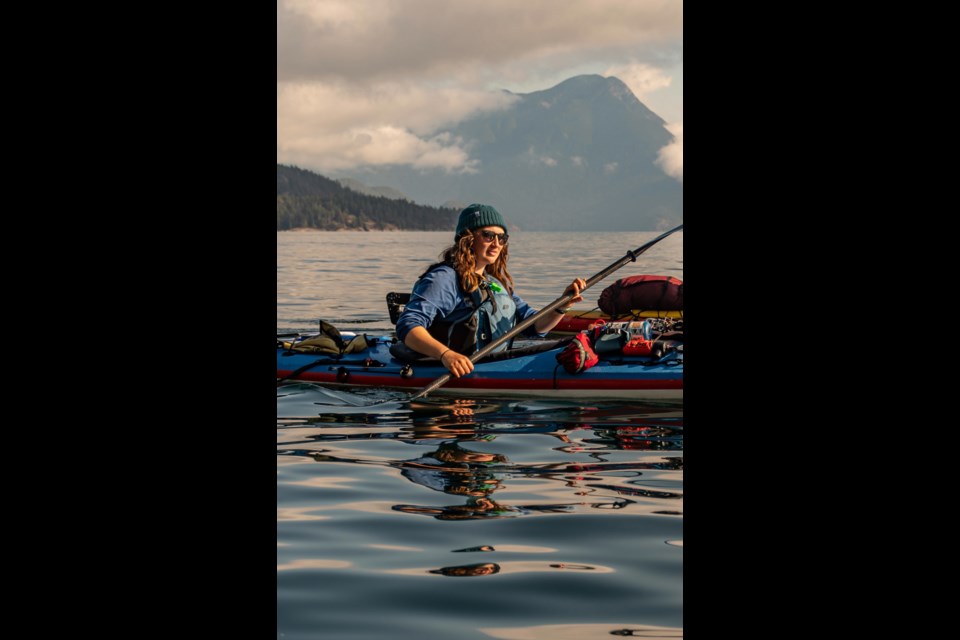The dehydrated meal market has exploded in popularity, especially for those wanting to pack light and easy on multiday hikes, such as the Sunshine Coast Trail or a kayak excursion in Desolation Sound Marine Park.
However, kayakers have some advantage over hikers when it comes to the types of food and supplies they can bring, due to the fact that kayakers have the luxury of floating on water, as opposed to the gravity of a heavy backpack weighing on their shoulders.
According to experienced kayaker and backcountry eating expert Ella Vallance, eating fresh, healthy, gourmet meals while on a multiday kayak tour is not only possible, but preferable.
Vallance is currently the menu creator and food curator at Powell River Sea Kayak. She spoke to the Peak about tips and tricks to eating well while on the water.
"One of the greatest things with sea kayaking is just the amount of space you have in a kayak," said Vallance. "So many people go into this thinking they're going to be eating freeze-dried, backcountry meals, dehydrated things."
Although Vallance and crew regularly prepare to feed up to 12 kayakers at a time, which is no easy feat, she said individual kayakers or couples can also bring delicious food to cook on a camp stove.
"We're sourcing all of our produce from local farms,” said Vallance. "So that's the beauty of kayaking, is just having the space in the kayak to bring more than you would if you were going on a backpacking trip, and carrying that weight on your back."
But, what about storage and keeping things fresh, so food doesn't go bad?
"How you store the food is super important, especially when you're out for a long period of time," said Vallance. "We like to put produce into containers if possible, like tomatoes or bananas; if you have some sort of container that can kind of house it, then that can really help the longevity of things out there."
Another concern is keeping food cool, since there is no access to refrigeration.
"We start our trips with small cooler bags that fit into the kayaks and have ice in them," said Vallance. "On days one, two and three, maybe you're having more cheeses, you have a bit of milk for coffee, things like that."
She said toward the end of the trip is when the dry goods can come in handy, and produce such as cabbage, since they can last longer.
"Personally, one of my favourites is to cook some sort of curry out there," said Vallance. "Coconut milk is a great base to use and then adding things like peanut butter, that stuff lasts a while out there, and then instant rice."
She said people shouldn't dismiss tofu as a good staple to bring on a kayak trip.
"There's so many cool things you can do with it, and it lasts a long time," said Vallance. "If you're able to purchase farm eggs that haven't been washed or refrigerated, those will last for days on end."
There may be lots of room in a kayak, but knowing how to pack is important.
"The way you pack your kayak is important," said Vallance. "I personally like to dedicate one hatch in my kayak just to my food and cooking equipment, and that way I know where things are."
She said food doesn't necessarily need to be in dry bags.
"The kayak caches are super drying 99 per cent of the time, as long as you have the cover on tight," said Vallance. "Organize produce in one bag, have your canned items in another bag, separating different items into categories that way."
Another go-to meal for Vallance is a falafel wrap.
"It's super easy to buy a falafel mix and just add water to it; that's the only ingredient that you have to cook with," she explained. "If you cook up those falafels in a pan, you can put tons of fresh ingredients into a pita wrap, for some extra carbs."
Water can be a concern while kayaking. One person on average needs at least three to four litres per day for drinking and cooking. Most people bring water with them in their kayak, but in places such as Tenedos Bay in Desolation Sound, fresh water can be accessed.
"We're using MSR Dromedary bags, the material is quite tough; they are fantastic, but a pricey item," said Vallance. "Some people will use four-litre jugs of water."
Vallance said she has kayaked many places, but Desolation Sound is her top choice for destinations.
"The marine park sites are super accessible," said Vallance. "They have pit toilets and 10 tent pads."
For more information, go to Ella Vallance (@lifeof.ellavallance)Instagram or to bcseakayak.com.
Join the Peak’s email list for the top headlines right in your inbox Monday to Friday.

.png;w=121;h=120;mode=crop)

